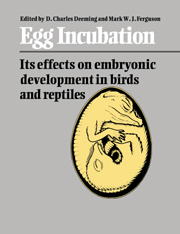Book contents
- Frontmatter
- Contents
- Preface
- Contributors
- 1 Maternal diet, maternal proteins and egg quality
- 2 Comparative composition and utilisation of yolk lipid by embryonic birds and reptiles
- 3 Oviductal proteins and their influence on embryonic development in birds and reptiles
- 4 Fluxes during embryogenesis
- 5 Eggshell structure and formation in eggs of oviparous reptiles
- 6 Shell structure and formation in avian eggs
- 7 Physical characteristics of reptilian eggs and a comparison with avian eggs
- 8 Egg-shape in birds
- 9 The thermal energetics of incubated bird eggs
- 10 Physiological effects of incubation temperature on embryonic development in reptiles and birds
- 11 Cold torpor, diapause, delayed hatching and aestivation in reptiles and birds
- 12 Physical factors affecting the water exchange of buried reptile eggs
- 13 Physiological and ecological importance of water to embryos of oviparous reptiles
- 14 Roles of water in avian eggs
- 15 Water economy and solute regulation of reptilian and avian embryos
- 16 The avian eggshell as a mediating barrier: respiratory gas fluxes and pressures during development
- 17 Gas exchange across reptilian eggshells
- 18 Metabolism and energetics of reptilian and avian embryos
- 19 Reasons for the dichotomy in egg turning in birds and reptiles
- 20 A comparison of reptilian eggs with those of megapode birds
- 21 Why birds lay eggs
- 22 Influences of incubation requirements on the evolution of viviparity
- 23 Overview of early stages of avian and reptilian development
- 24 Ions and ion regulating mechanisms in the developing fowl embryo
- 25 Electrochemical processes during embryonic development
- 26 Methods for shell-less and semi-shell-less culture of avian and reptilian embryos
- 27 Experimental studies on cultured, shell-less fowl embryos: calcium transport, skeletal development, and cardio-vascular functions
- Index
14 - Roles of water in avian eggs
Published online by Cambridge University Press: 16 November 2009
- Frontmatter
- Contents
- Preface
- Contributors
- 1 Maternal diet, maternal proteins and egg quality
- 2 Comparative composition and utilisation of yolk lipid by embryonic birds and reptiles
- 3 Oviductal proteins and their influence on embryonic development in birds and reptiles
- 4 Fluxes during embryogenesis
- 5 Eggshell structure and formation in eggs of oviparous reptiles
- 6 Shell structure and formation in avian eggs
- 7 Physical characteristics of reptilian eggs and a comparison with avian eggs
- 8 Egg-shape in birds
- 9 The thermal energetics of incubated bird eggs
- 10 Physiological effects of incubation temperature on embryonic development in reptiles and birds
- 11 Cold torpor, diapause, delayed hatching and aestivation in reptiles and birds
- 12 Physical factors affecting the water exchange of buried reptile eggs
- 13 Physiological and ecological importance of water to embryos of oviparous reptiles
- 14 Roles of water in avian eggs
- 15 Water economy and solute regulation of reptilian and avian embryos
- 16 The avian eggshell as a mediating barrier: respiratory gas fluxes and pressures during development
- 17 Gas exchange across reptilian eggshells
- 18 Metabolism and energetics of reptilian and avian embryos
- 19 Reasons for the dichotomy in egg turning in birds and reptiles
- 20 A comparison of reptilian eggs with those of megapode birds
- 21 Why birds lay eggs
- 22 Influences of incubation requirements on the evolution of viviparity
- 23 Overview of early stages of avian and reptilian development
- 24 Ions and ion regulating mechanisms in the developing fowl embryo
- 25 Electrochemical processes during embryonic development
- 26 Methods for shell-less and semi-shell-less culture of avian and reptilian embryos
- 27 Experimental studies on cultured, shell-less fowl embryos: calcium transport, skeletal development, and cardio-vascular functions
- Index
Summary
Introduction
This chapter is an account of some thoughts and ideas that have been crystallised during the many years of working the field of avian egg physiology. It cannot and will not cover all aspects of the immense quantity of published work. My choice of references is much biased by their relevance to my way of viewing the issue of embryonic development in a cleidoic system – a problem nature has solved while we are still pondering how.
Water loss from avian eggs
Homeothermy and water loss from eggs
Birds have developed an active and intensive lifestyle, which requires homeothermy. Simultaneously, by maintaining a high incubation temperature, their embryos have evolved to develop fast in comparison with reptiles of the same size (Rahn & Ar, 1974; Blueweiss et al., 1978; Deeming & Ferguson, Chapter 10).
Thermoregulation in adult birds is associated with the presence of insulating plumage, which developed to replace reptilian scales. Regarding egg thermoregulation, most birds lay eggs in the still air which acts as an insulating medium in the nest, while many reptiles lay eggs in a soil substrate. This difference is not trivial: soil, and especially wet soil, both conducts heat well and has a high heat storage capacity (Table 14.1) (Hillel, 1978). Hence, eggs in direct contact with the soil exchange heat easily and cannot become much warmer than their surroundings, even if they were actively incubated.
- Type
- Chapter
- Information
- Egg IncubationIts Effects on Embryonic Development in Birds and Reptiles, pp. 229 - 244Publisher: Cambridge University PressPrint publication year: 1991
- 24
- Cited by



